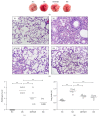The Modified JiuWei QiangHuo Decoction Alleviated Severe Lung Injury Induced by H1N1 Influenza Virus by Regulating the NF- κ B Pathway in Mice
- PMID: 26089947
- PMCID: PMC4451524
- DOI: 10.1155/2015/790739
The Modified JiuWei QiangHuo Decoction Alleviated Severe Lung Injury Induced by H1N1 Influenza Virus by Regulating the NF- κ B Pathway in Mice
Abstract
A new approach to treat infections of highly pathogenic influenza virus is to inhibit excessive innate immune response. JiuWei QiangHuo decoction has been used for centuries for the treatment of pulmonary disorders in China. In this study, we evaluated the anti-inflammatory activities of the modified JiuWei QiangHuo (MJWQH) decoction in the treatment of influenza A (H1N1) virus-induced severe pneumonia in mice. The results showed that MJWQH significantly increased the survival rate of H1N1-infected mice and suppressed the production of TNF-α, IL-1, IL-6, MCP-1, RANTES, and IFN-α on day 4 after infection. Moreover, oral administration of MJWQH efficiently inhibited virus replication and alleviated the severity of lung injuries. The results also showed that MJWQH may have potential therapeutic effect on severe lung injury induced by H1N1 virus by regulating the NF-κB pathway. Our study suggested that MJWQH might be an alternative therapy for the treatment of viral pneumonia.
Figures









References
-
- Hsu C.-H., Hwang K.-C., Chao C.-L., et al. An evaluation of the additive effect of natural herbal medicine on SARS or SARS-like infectious diseases in 2003: a randomized, double-blind, and controlled pilot study. Evidence-Based Complementary and Alternative Medicine. 2008;5(3):355–362. doi: 10.1093/ecam/nem035. - DOI - PMC - PubMed
LinkOut - more resources
Full Text Sources
Other Literature Sources
Miscellaneous

